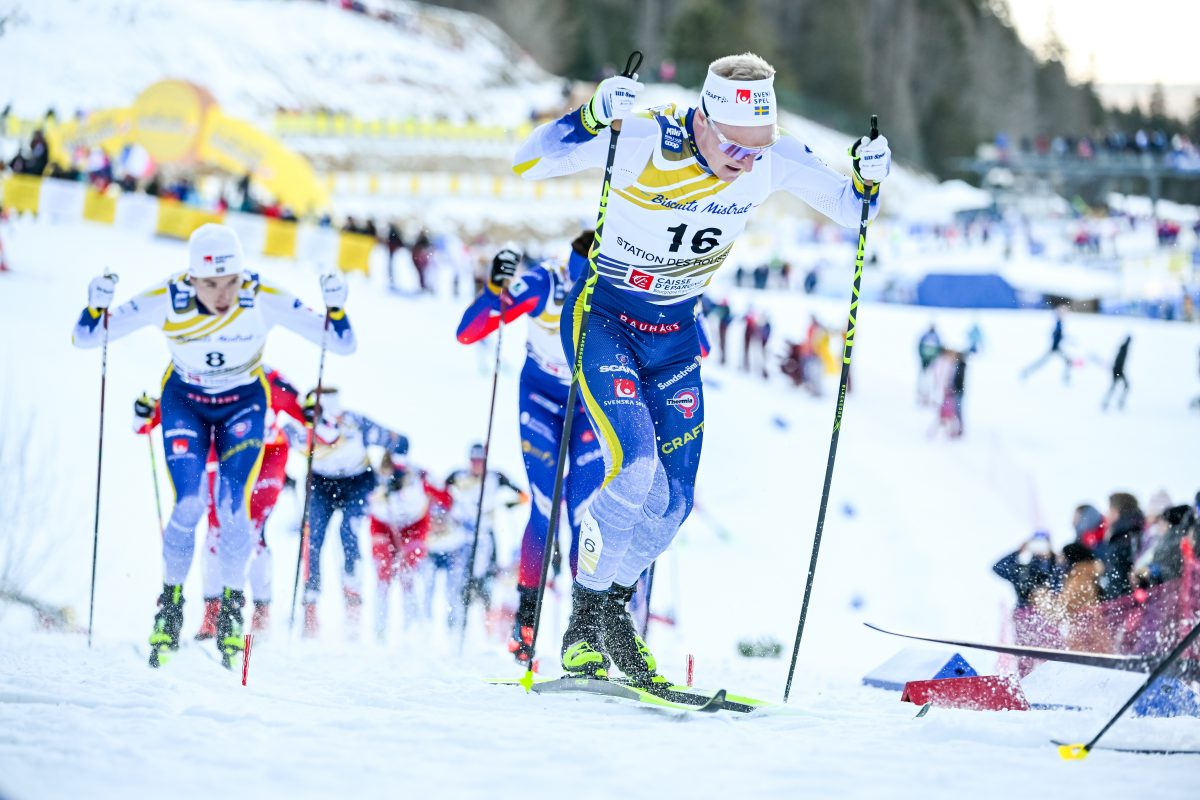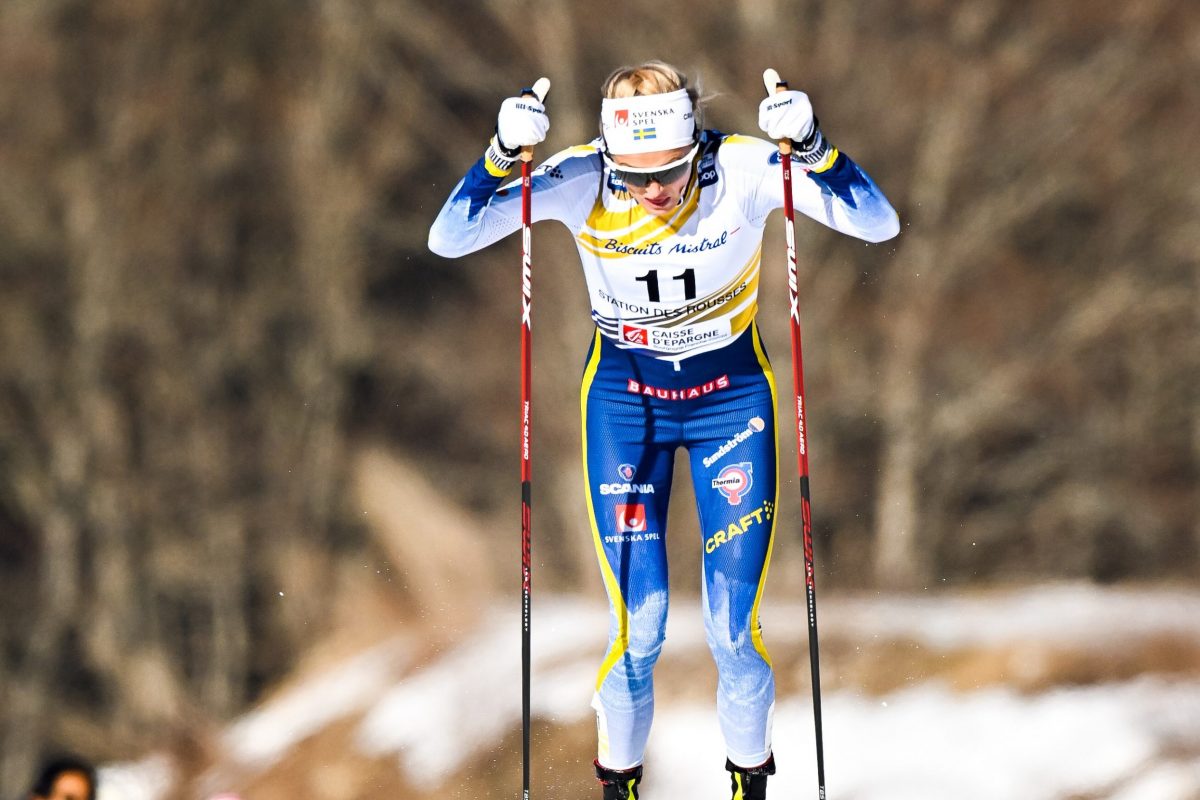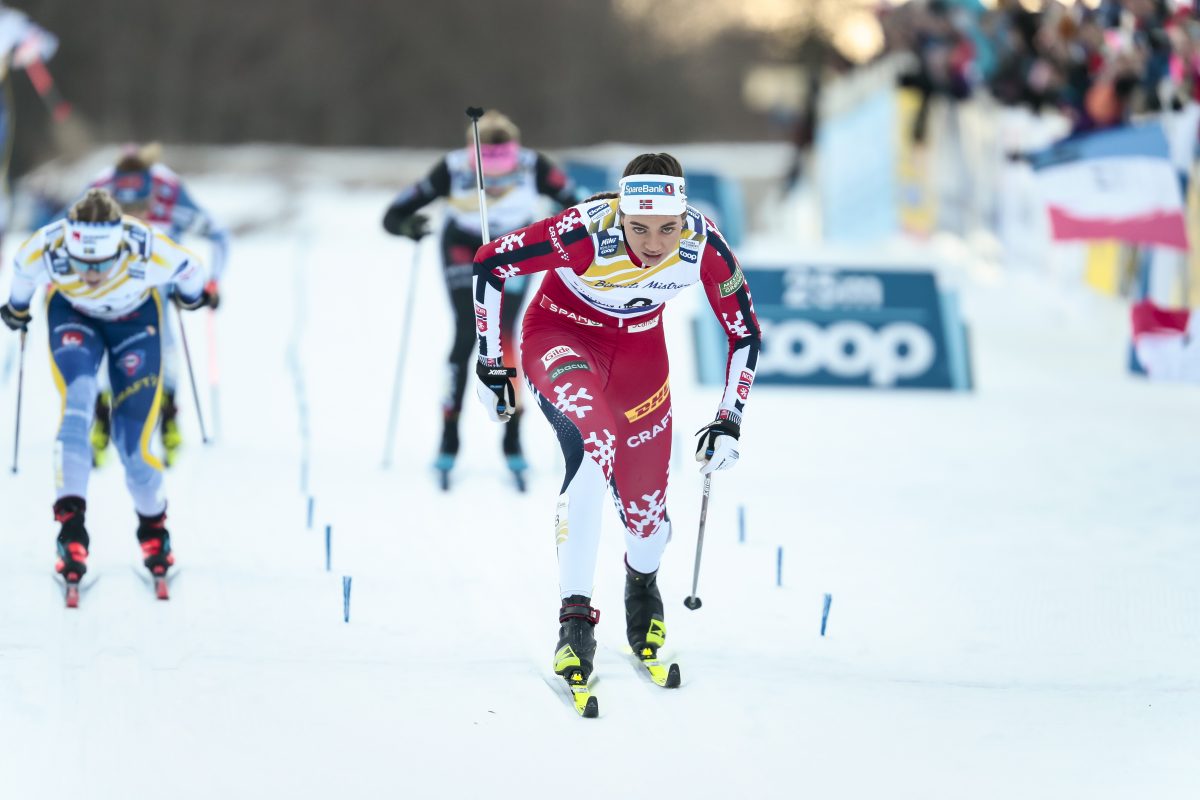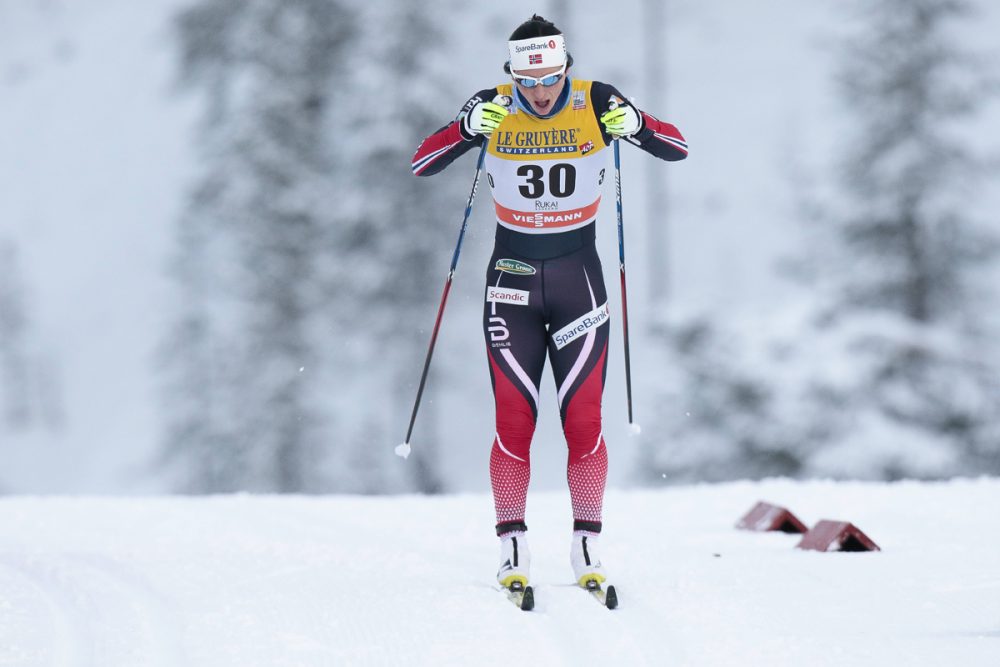
280 days.
That’s the average gestation time for a human baby. Then there’s the post-birth energy drain: the near constant feeding, lack of sleep. It’s a perpetual expenditure of calories.
Two days of racing.
That’s all it took of the race season for Norway’s Marit Bjørgen to win a World Cup. And to be more precise, it took 26:55.2 minutes — her winning time on Sunday’s 10-kilometer classic individual start in Kuusamo, Finland.
After having missed all of last season with the birth of her first child last December, Bjørgen took charge on Sunday. Her grip on the race wasn’t a work in progress. It was immediate. At the first splt, 3.1 k into the race, this was clear: Bjørgen’s back.
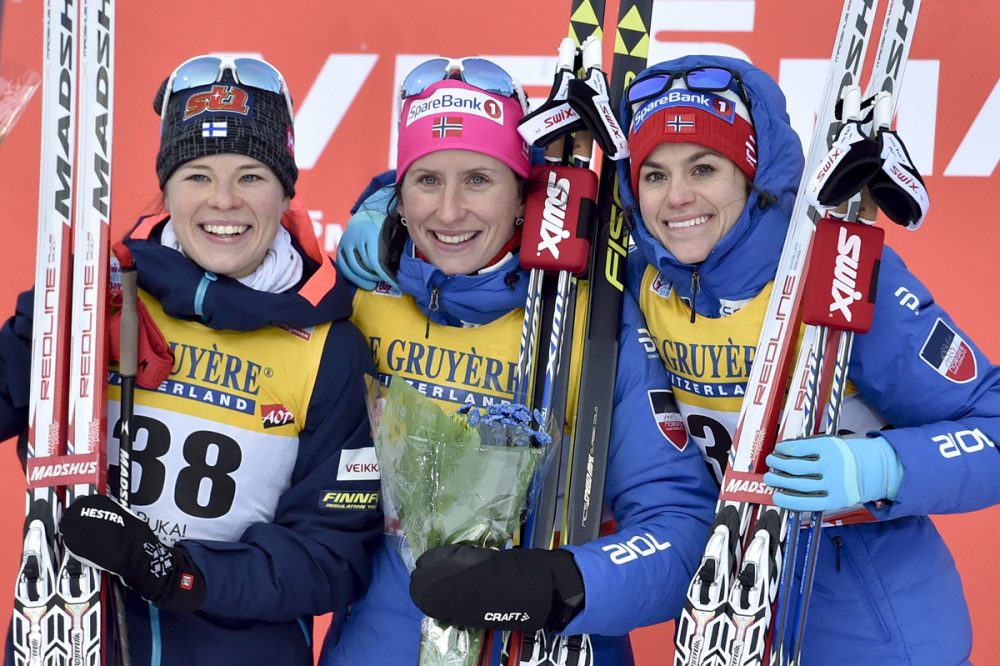
That’s when Bjørgen marked the fastest split. And she ran the board with the fastest splits at 5 k and 8.1 k, culminating with a 4.6-second victory over Finland’s Krista Parmakoski, who skied to second place.
Bjørgen’s teammate Heidi Weng took her second podium in as many days, placing third (+12.7).
Norway’s winning streak in 10 k classic individual-start races was extended to 11 in a row on Sunday. It also marks Bjørgen’s 14th victory in the event.
Although Bjørgen’s life has taken on new real-world concerns, she made her first World Cup distance race since her pregnancy and child’s birth seem like a fairy tale. Her dream of taking time off from elite sport, starting a family and returning to dominant form — it’s reality.
“I felt after the first lap that I had more to give, then I got some help from a German Victoria [Carl], who is very strong in the easy/flat parts of the race,” Bjørgen told Norwegian Broadcaster NRK after the race. “So I stayed behind her and was able to ski well in the hills, so yeah it was a good tactical race.”
In that same interview, the 36-year-old four-time Overall World Cup winner said her fitness compass hasn’t lead her astray. Instead of due north, the needle still points toward the win.
“It feels really great, absolutely, I feel like I’ve done well this fall, even if the summer was challenging, my own compass has been pointing in the right direction, so it feels really great yea,” she told NRK.
Her victory on Sunday, although sentimental, also proves that for others the new Bjørgen is really the old Bjørgen — powerful, fast and a clinical hunter when it comes to podiums. Weng, the third-place finisher, took note.
“She’s a machine,” Weng commented to NRK. “I said it beforehand, she will be back after having a kid and she will win. It’s insane.”
Three in the points for the U.S. women
The U.S. women placed three in the points, with U.S. Ski Team member (USST) Jessie Diggins in 13th (+1:09), Sadie Bjornsen (USST) 17th (+1:14.9), and Caitlin Patterson, of the Craftsbury Green Racing Project, in 28th (+1:45.4). Patterson, 26, earned Period 1 World Cup starts as last season’s overall SuperTour winner.
Despite a wintery scene to jumpstart the season in Ruka, Diggins’s world was at ease with the World Cup hustle.
“In some ways it was really easy to slip right back in the rhythm,” she said of the World Cup circus. “I am a total social butterfly so I am running around like, ‘Hi, hi, hi,’ talking to all my friends at the World Cup and that part was really fun.”
Along with systematically picking skis with her coach Jason Cork, the routine of warming up and then dialing in the race-pacing calculus, Diggins raced with mid-season poise.
On course, it was a hard-driving Diggins.
“I was getting some splits out there. It’s hard for me to listen exactly to the coaches when I am skiing out of my mind tired,” she said. Her splits would have revealed her effort was just off top-10 pace. After 3.1 k, Diggins was in 10th, 17 seconds out of first. Over the course of the race, she dropped back to 14th and 15th at 5 k and 8.1 k, respectively, but gained a few spots by the finish.
Asked about her 13th place, the Stratton Mountain School (SMS) T2 Team skier best known for her skate skiing said it was a welcome early season wake up. “I didn’t feel like a hero out there. I had spit all over my face and was drooling all over, but it was a great surprise,” she said.
U.S. Ski Team Women’s Coach Matt Whitcomb said he, too, liked what he witnessed from Diggins.
“It was great to see, watching Jessie,” Whitcomb said. “She was just engaged in this race from start to finish. Had that really hungry look on her face and good dynamic movements in her body the entire 10 kilometer race. So I felt really good about where she is; 13th place after a week on the ground in Europe is really phenomenal as well as on really challenging classic courses that haven’t always been her strength, so the work that she’s put in in her classic skiing over the last couple years has been significant and it’s worked.”
Diggins said she has taken responsibility for improving her classic technique. Those improved physical sensations have allowed her to embrace the kick-wax mantra of ‘thin to win’.
“Working with my tech in past years I’ve often just said give me kick at the expense of everything else because I don’t feel confident getting up the hill,” Diggins said about her reliance on more kick, less glide. “So I would ask for so much kick that I shorted myself on glide, which is obviously my fault. I’m not trying in anyway to blame anyone else, I’m just saying that in past years I wouldn’t have the confidence to go with the appropriate ratio of kick to glide and I’m finally starting to learn how to get it a little more at the right ratio … and so that has been really cool working with the coaches on that to get my technique and confidence up to the point where I can give myself a better chance at climbing.”
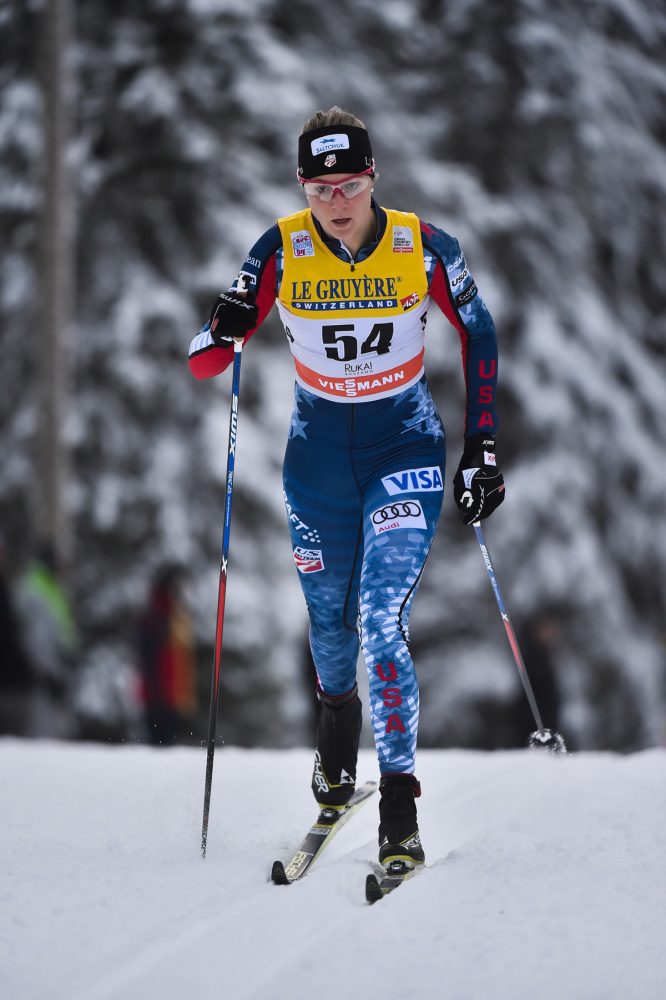
Although not a surprise to find herself well within the points in 17th, Bjornsen was cautiously optimistic coming into Sunday’s race.
“I kind of came into this weekend without having specific expectations, but more just to set a benchmark for where to start from,” Bjornsen said.
During the offseason, Bjornsen, an omnipresent World Cup all-arounder, has been dealing with bone spurs on her feet.
“It’s particularly hard with a weekend of classic racing because it’s only my fourth time classic-ing in the last two months,” she explained. “So I don’t really have the perfect feel yet, but it’s definitely coming back. So I guess I feel encouraged by how things are starting, but I definitely have huge hopes for the weekends to come.”
If she had any questions about her fitness, they’ve been answered. A 10 k effort on Ruka’s steep terrain, going against skiers fighting for their World Cup start rights, Bjornsen couldn’t exactly fake it.
“Sadie had a pretty slow start,” Whitcomb said of her initial splits. “I was giving splits at one point at 1.2, which was also the 6.2-kilometer mark, and she had about a 15- or 16-second deficit at 1.2 k, so that’s always kind of an early warning that the body’s not quite firing. So that was a little bit scary. But a little further into the race, she started coming to life and the attention of the crowd started to draw on Sadie. She was not far from the top 10 today, she was certainly fighting with four or five other girls that all ended up within just a handful of seconds.”
Bjornsen hasn’t had a text book run-up to the season. For the former competitive swimmer, it’s been a lot of SkiErg-ing and tons of laps in the pool.
“It’s funny because I’ve done SkiErg-ing intervals and I’ve done one bounding session,” Bjornsen said of her recent training. “I just haven’t done anything remotely like racing for some time now. So in sprinting you just go as hard as you can. It’s kind of simple, you don’t have to remember how to pace anything because you just send it. So yesterday in my qualifier, I was blown away that I was able to race into seventh place. But today I was like, ‘OK, I guess you have to pace a 10 k a little bit.’ But the most that I’ve done is two-minute intervals on the SkiErg or, I did a bounding session that I did four-minute intervals, but I just haven’t done a consistent 30-minute effort.”
Bjornsen explained her early split, 23rd place at 3.1 k, as a function of starting too easy.
“I think I was just too cautious out of the beginning and I didn’t even realize it,” she said. “I honestly got to the top of the first hill and I was like, ‘Oh, I hope I didn’t go too hard at the start.’ But I think I was in 37th place. At the time Matt [Whitcomb] was like, ‘All right, time to get into it!’ but I had no idea I was way out of the race already … But it took me two kilometers to remember how to go again and I pushed it for the rest of the way and I think I gained some places back. Even that is super encouraging because I feel like next time I go out and do a distance race, I’m going to have the confidence to go a little harder at the beginning.”
The first-weekend race hurdle is over for Bjornsen, a skier who realistically eyes top-10s as newsworthy. She’ll still head into the next World Cup in Lillehammer, Norway, problem solving when it comes to pain-free skiing.
“I still haven’t quite figured it out yet, but it’s really nice to get over here and work with the boot guys and try to figure out a solution. But I haven’t cleared the bone-spur problem yet,” she said.
Maybe no real surprises so far: Three Norwegians in the top four, four in the top ten. Two U.S. skiers in the top twenty.
Then this:
“Caitlin Patterson, it’s not very often that we have COC [Continental Cup] athletes that score points,” Whitcomb said. “Just straight up, that’s a tough thing to do … Being the Continental Cup leader, it’s a tall order to get in the top 30. So Caitlin has now put together, really, a series of races starting last year that’s showing the world that she’s supposed to be here. So that’s really exciting.”
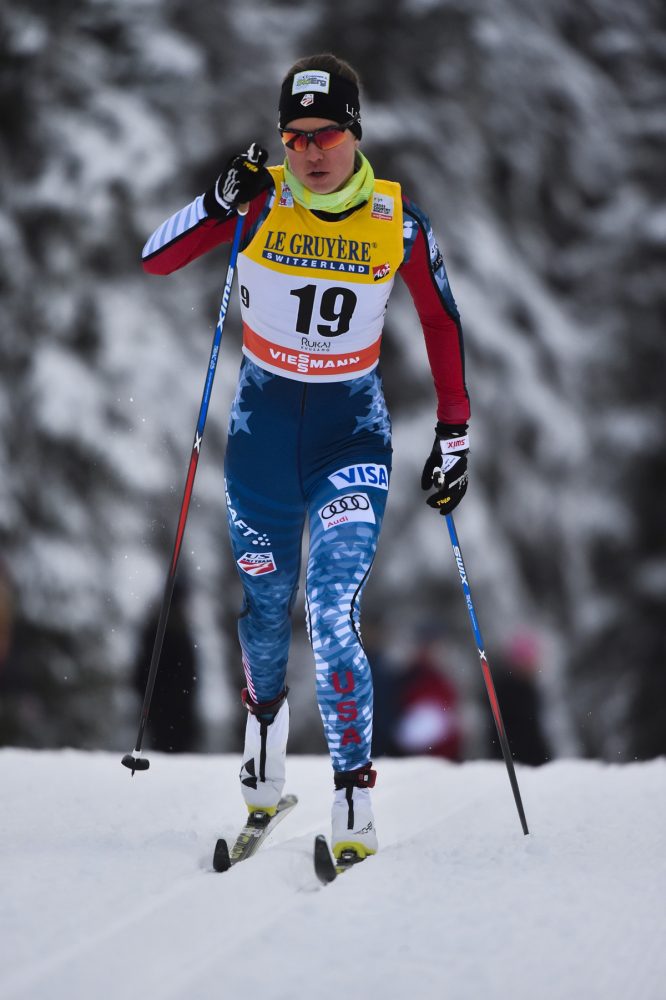
According to the International Ski Federation (FIS) website, this is Patterson’s 15th World Cup start. Not exactly green, but she’s not the most seasoned on the World Cup.
“I figured she would be skiing as a points skier this year,” Whitcomb said when asked about his expectations for Patterson. “I wasn’t sure if it would happen already. She showed some signs of life in Muonio [Finland] that definitely turned some heads. So that was a good indicator a couple weeks ago that she was in good shape. She’s been telling that to us all along and we got to see it today and that was impressive.”
For the Alaska native, being in the points is confirmation.
“I’m definitely pretty happy with it — it was a really solid race and I knew it wasn’t going to be easy at all to squeak into the points here,” Patterson said of her performance. “It’s just typically Period 1 is really tough, there’s so many Scandinavians and really tough competitors out here.”
Not being a national-team member, she’s had to trust that what she’s been doing is World Cup worthy.
“I’ve had a little bit of comparison with some of the other girls, but I’ve mostly just had to trust that my own training has been quite good and more often than not I am training with my other Green Team Members like Kate Miller, and Liz Guiney and others,” Patterson said. “So it’s not necessarily so much World Cup skier comparison but I just have to trust that my own training is going well.”
Patterson’s first official split at 3.1 k put her in 32nd place. From there on, she was in the top 30, in the points. Like no other statement, results matter at this level. And Patterson understands the benchmark by which she is being judged.
“It’s a really good step along the progression of trusting that I belong here and that I can compete with these girls,” Paterson noted about her ability to compete on the World Cup. “I did look at the finishing results and saw that, what was it like, that if I could’ve been like 10 seconds faster, that was 6 places or something … it was like 40 seconds to the top 10 or something. So those things are really encouraging.”
Some U.S. skiers were out of the points which helps explain Whitcomb’s summation of the women’s race. “I’m very satisfied with the race today,” Whitcomb said. “It was a mix of great races and some races with disappointed athletes attached to the result. But as a team I think we skied pretty well and even those that were, some that were wanting more had some good elements that went down today so I’m happy.”
Also for the U.S. Ski Team, Rosie Brennan placed 39th (+2.22), Kikkan Randall skied to 43rd (+2:29.7), Ida Sargent 44th (+2:30.4), and Sophie Caldwell 61st (+3:13.4).
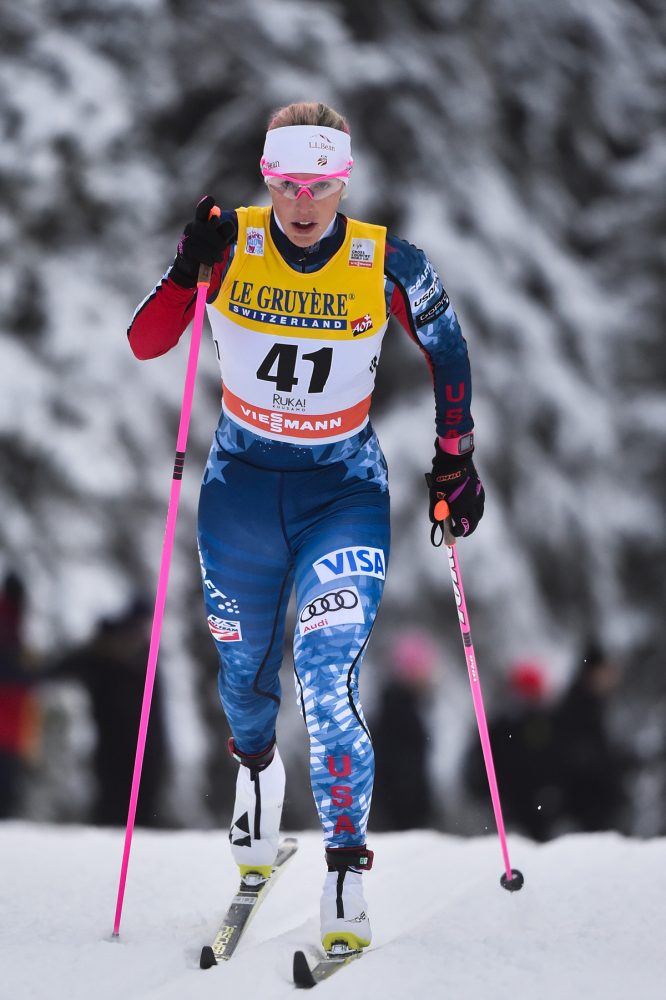
Randall is a longtime U.S. Ski Team member and former three-time winner of the Sprint World Cup. Also, like race-winner Bjørgen, Randall took last season off for the birth of her first child.
“I was looking forward to another chance to test myself today,” Randall wrote in an email to several media outlets, referring to her missing out on the heats in Saturday’s classic sprint. “I had a feeling distance may be better for me right now with less intensity in my system as normal.
“I paced myself a little too well,” she continued. “I lost 20 seconds in the first 1.5km and already 1:10 by halfway. Kept about the same pace 2nd lap. Had good energy in the end so I definitely could have gone out a little harder. … I need more hard efforts to get re accustomed with race pace after a year without it. I hope to get a spot to race the mini tour in Lillehammer next week and will look forward to some skate races in Davos!”
Whitcomb mentioned that for Randall, the first weekend does not reflect her race potential.
“She started out very slowly and I can’t say that I’m entirely surprised with that,” Whitcomb said of Randall’s split at 3.1 k, which ranked 51st. “She sometimes takes a little bit to get going in the distance races and having been away from it for so long, I wasn’t sure what to expect. But that was one of the leading options. But what was very cool is she started to turn things up about halfway through the race so the body started to respond and showed signs of life, and she’s had a great attitude all weekend.”
Whitcomb also sensed the importance of the moment for elite athletes when commenting on Bjørgen’s win. “I thought it was a little disrespectful that she only gave us one race where she let somebody else win, then today she was right back at it again,” he said with a laugh. “Marit’s one of those skiers that everybody’s happen when she wins, not just Norway, so you can count me as one of those fans cheering her on.”
“Inspiring and motivating to see both Bjørgen and [Finland’s Aino-Kaisa] Saarinen [who placed 16th] ski so well,” Randall wrote. “Marit is a few months ahead of me so I am optimistic about this season as it progresses. We have been talking Mom and baby stuff between the 4 of us (also Katja Visnar), it’s a fun new conversation.”
Canada entered three skiers in Sunday’s distance race. Twenty-three-old national U25 Team member Cendrine Browne was 58th (+3:04.8), World Cup B-team member Emily Nishikawa was 59th (+3:07.1), and Dahria Beatty (U25 Team) was 74th (+3:54.4).
Sweden’s Stina Nilsson, who won Saturday’s classic sprint, leaves Ruka as the World Cup overall leader with Marit Bjørgen in second, 10 points behind. Racing resumes next Friday with three days of racing in Lillehammer.
Women’s 10 k classic results | Overall World Cup Standings
Jason Albert
Jason lives in Bend, Ore., and can often be seen chasing his two boys around town. He’s a self-proclaimed audio geek. That all started back in the early 1990s when he convinced a naive public radio editor he should report a story from Alaska’s, Ruth Gorge. Now, Jason’s common companion is his field-recording gear.

